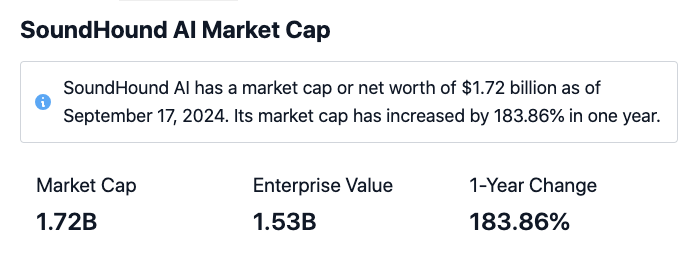Optimizing your computational resources can help you to trade AI stocks effectively, especially in copyright and penny stocks. Here are 10 suggestions for maximising your computational capabilities:
1. Cloud Computing to Scale Up
Tip: Use cloud-based services, like Amazon Web Services(AWS), Microsoft Azure (or Google Cloud), to increase the computing power of your computer according to demand.
Why: Cloud services offer flexibility to scale up or down depending on the amount of trades and data processing requirements and model complexity, especially when trading in highly volatile markets, such as copyright.
2. Choose High-Performance Hard-Ware for Real-Time Processing
Tip. The investment in high-performance computers that include GPUs and TPUs, is perfect to use for AI models.
Why: GPUs/TPUs dramatically accelerate model training and real time processing of data. This is essential for quick decision-making on high-speed markets such as penny stocks or copyright.
3. Optimize Data Storage Speed and Access
Tip: Choose storage solutions which are energy efficient like solid-state drives, or cloud storage services. These storage services provide rapid data retrieval.
The reason is that AI-driven decisions which require quick access to historical and real-time market data are crucial.
4. Use Parallel Processing for AI Models
Tip: Use parallel computing to accomplish multiple tasks at once for example, such as analyzing different markets or copyright assets.
Parallel processing speeds up data analysis and modeling training. This is especially the case when working with huge data sets.
5. Prioritize edge computing to facilitate trading at low-latency
Use edge computing where computations can be processed nearer to the source of data (e.g. exchanges or data centers).
Edge computing is crucial in high-frequency traders (HFTs) and copyright exchanges, where milliseconds count.
6. Enhance the Efficiency of the Algorithm
Tips: Fine-tune AI algorithms to improve effectiveness in both training and operation. Techniques like pruning (removing important parameters from the model) could be beneficial.
Why? Because optimized models are more efficient and consume less hardware, while still delivering efficiency.
7. Use Asynchronous Data Processing
Tip - Use asynchronous processing of data. The AI system can process data independently of other tasks.
The reason: This technique increases the system's throughput and minimizes the amount of downtime that is essential for fast-moving markets such as copyright.
8. Manage Resource Allocation Dynamically
Tips: Make use of resource allocation management software, which will automatically allocate computing power according to the workload.
Why is this: Dynamic resource distribution assures that AI models run effectively and without overloading the system. This can reduce the time it takes to shut down in times that have high volumes of trading.
9. Use light models for real time trading
Tips: Choose models that are lightweight machine learning that can quickly make decisions based on information in real time, without requiring many computing resources.
Why? For real-time trades (especially in the penny stock market or copyright) the ability to make quick decisions is more important than complex models as the market's conditions will alter quickly.
10. Control and optimize the cost of computation
Tip: Monitor and improve the performance of your AI models by tracking their computational costs. Pick the appropriate pricing plan for cloud computing based on the features you need.
The reason: Using resources efficiently will ensure that you don't spend too much on computational resources. This is crucial when trading penny stock or volatile copyright markets.
Bonus: Use Model Compression Techniques
You can decrease the size of AI models by employing models compression techniques. These include quantization, distillation, and knowledge transfer.
Why? Compressed models maintain performance while being resource-efficient. This makes them perfect for trading in real-time where computational power is not sufficient.
By following these suggestions by following these tips, you can improve your computational capabilities and make sure that the strategies you employ for trading penny shares and copyright are cost-effective and efficient. Follow the recommended ai stock price prediction for blog tips including ai stock prediction, ai copyright trading bot, ai stock, ai in stock market, ai trading, incite ai, ai penny stocks to buy, ai investment platform, copyright ai trading, stock analysis app and more.

Top 10 Tips For Paying Attention To Risk Measures For Ai Stock Pickers ' Predictions For Stocks And Investments
A close eye on risk metrics will ensure that your AI-based stock picker, investment strategies, and predictions are well balanced and resilient to changes in the markets. Knowing and managing risk can help protect your portfolio from large losses and lets you make informed, data-driven decisions. Here are 10 best strategies for integrating risk-related metrics into AI stock picking and investment strategies:
1. Understanding key risk measures Sharpe ratios, Max drawdown, volatility
TIP: Pay attention to key risk indicators like the Sharpe ratio, maximum drawdown, and volatility to assess the performance of your risk-adjusted AI model.
Why:
Sharpe ratio measures the amount of return on investment compared to the risk level. A higher Sharpe ratio indicates better risk-adjusted performance.
You can use the maximum drawdown in order to determine the maximum loss from peak to trough. This will allow you to better understand the possibility of massive losses.
Volatility quantifies the price fluctuations and risks of the market. Higher volatility means higher risk, while lower volatility signals stability.
2. Implement Risk-Adjusted Return Metrics
Tip: To evaluate the performance of your AI stock picker, make use of risk-adjusted measures such as Sortino (which focuses primarily on risk that is a downside) and Calmar (which examines the returns to the maximum drawdown).
What are the reasons: The metrics will reveal the way your AI model performs in relation to its risk level. This will allow you to determine if the risk is justifiable.
3. Monitor Portfolio Diversification to Reduce Concentration Risk
Use AI optimization and management tools to ensure your portfolio is well diversified across the different types of assets.
Diversification helps reduce the risk of concentration. This happens when a portfolio is overly reliant on a single sector, stock or market. AI can be used for identifying correlations between different assets, and altering the allocations in order to lessen risk.
4. Track Beta to Determine Market Sensitivity
Tip: Use the beta coefficient as a method to determine how responsive your portfolio is to overall market changes.
The reason: A portfolio with more than 1 beta is more volatile than the stock market. Conversely, a beta lower than 1 indicates an underlying lower risk of risk. Knowing beta lets you tailor your risk exposure according to the market's fluctuations and the risk tolerance of the investor.
5. Implement Stop-Loss Levels, Take-Profit and Take-Profit Based on Risk Tolerance
To limit the risk of losing money and to lock in profits, you can set stop-loss limits or take-profit limit by using AI forecasting and risk models.
The reason: Stop-loss levels shield you against excessive losses while the take-profit level secures gains. AI can identify optimal levels by studying historical price changes and the volatility. This allows you to keep a healthy equilibrium between risk and reward.
6. Monte Carlo simulations can be used to evaluate the level of risk in various scenarios.
Tips : Monte Carlo models can be utilized to assess the potential results of portfolios in different market and risk conditions.
What is the reason: Monte Carlo Simulations give you an opportunity to look at probabilities of your portfolio's performance in the future. This allows you to better understand and plan for different risk scenarios, like large loss or high volatility.
7. Evaluation of Correlation to Determine Risques that are Systematic or Unsystematic
Tips: Make use of AI to study the correlations between the assets you have in your portfolio and market indices in general to detect both unsystematic and systematic risks.
Why: While systemic risks are common to the market as a whole (e.g. downturns in economic conditions) Unsystematic risks are specific to particular assets (e.g. problems pertaining to a specific company). AI can help reduce unsystematic as well as other risks by suggesting less-correlated assets.
8. Monitor value at risk (VaR), to quantify potential losses
Tip: Use Value at Risk (VaR), models that are based on confidence levels to determine the risk in a portfolio over a timeframe.
Why is that? VaR lets you know what the most likely scenario for your portfolio would be in terms of losses. It allows you the opportunity to assess the risk of your portfolio under regular market conditions. AI helps calculate VaR dynamically adapting to changing market conditions.
9. Create Dynamic Risk Limits based on Market Conditions
Tip : Use AI to adjust the risk limit based on market volatility and economic conditions, as well as relationships between stocks.
What is the reason? Dynamic risks your portfolio's exposure to risky situations in the event of high volatility or uncertain. AI analyzes data in real-time to adjust your portfolio and maintain your risk tolerance at acceptable levels.
10. Use Machine Learning to Predict Risk Factors and Tail Events
Tip: Use historical data, sentiment analysis, as well as machine-learning algorithms to identify extreme or high risk events (e.g. Black-swan events, stock market crashes incidents).
The reason: AI can help identify risks that traditional models might not be able detect. They also can predict and help you prepare for the most rare however extreme market conditions. The analysis of tail-risks assists investors to understand the potential for catastrophic loss and plan for it ahead of time.
Bonus: Reevaluate risk-related metrics regularly with the changing market conditions
TIP When market conditions change, you should constantly reassess and re-evaluate your risk-based models and indicators. Refresh them to reflect changing economic geopolitical, financial, and elements.
Reason: Market conditions shift frequently, and using outdated risk models may lead to an inaccurate risk assessment. Regular updates are required to ensure that your AI models can adapt to the latest risk factors, as well as accurately reflect the market's dynamics.
This page was last modified on September 29, 2017, at 19:09.
By monitoring the risk indicators carefully and incorporating them in your AI investment strategy, stock picker and prediction models, you can create an intelligent portfolio. AI is a powerful tool that can be used to manage and assess risks. Investors are able to make informed data-driven choices and balance potential returns with acceptable risks. These guidelines will enable you to create a robust management plan and ultimately improve the security of your investments. Read the recommended best copyright prediction site for website info including ai investment platform, best stock analysis website, ai for stock trading, stock analysis app, ai trade, ai trading, ai copyright trading bot, ai for trading stocks, copyright ai, best ai trading bot and more.
